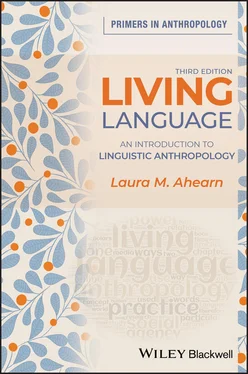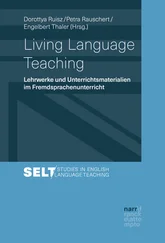11 Part III Language, Power, and Social Differentiation 10 Language and GenderWhat is Gender, and How Does it Relate to Language?Do Men and Women Speak Alike or Differently?Do Women and Men of All Ages and All Ethnic, Racial, and Cultural Backgrounds Share the Same Gendered Differences in Their Language Use?Some Thoughts on Myths and Realities11 Language, Race, and EthnicityDefining Race and EthnicityThe Rule-Governed Nature of African American EnglishInvariant or Habitual “Be”Copula DeletionDouble NegativesThe Reduction of Final ConsonantsPronouncing the Word “Ask” as “Aks”Racist Language and Racism in LanguageLanguage and Racial/Ethnic IdentitiesConclusion12 Language Endangerment and RevitalizationEnumerating the Crisis: How Many Endangered Languages are There?What Dies When a Language Dies?Why Do Languages Die?Can Endangered Languages Be Saved?Conclusion13 Conclusion: Language, Power, and AgencyWhat Is Power?HegemonyFoucault’s Power Relations and DiscoursePractice Theory and PowerAgencyThe Grammatical Encoding of AgencyTalk About Agency: Meta-Agentive DiscoursePower and Agency In/through/by/of Language
12 Notes
13 References
14 Index
15 End User License Agreement
1 Chapter 11.1 Cartoon demonstrating how certain styles of speech can both reflect and shape social identities.1.2 Khim Prasad (left) during the Pounded Rice Ritual, with the bride, Indrani Kumari (seated at the right, completely covered by a shawl), and the bridal attendant (standing in the center).1.3 “Zits” cartoon about the varying cultural meanings associated with language use.1.4 Jakobson’s model of the multifunctionality of language.1.5 Cartoon playing off the language ideology that considers French a romantic language.1.6 Semiosis as a relation between relations.
2 Chapter 22.1 A gesture with many possible meanings: “Peace,” “V for victory,” or “Turn around, I want to kiss you”.
3 Chapter 44.1 The cultural concepts of hed and save in Gapun, Papua New Guinea.
4 Chapter 55.1 Relationship between language and thought according to the (mistaken) “strong” version of the Sapir–Whorf Hypothesis.5.2 Scene from 2016 film Arrival. Picture credit: Paramount Pictures.5.3 Relationship among language, thought, and culture according to contemporary understandings of the Sapir–Whorf Hypothesis within linguistic anthropology.5.4 Cartoon ridiculing the tendency of some scholars (especially those without any training in linguistics or anthropology) to make tendentious claims about the effects of a lack of a specific word in a given language.5.5 Another of the many representations in popular culture of the “Eskimo words for snow” myth.5.6 Set-up for experiment involving coordinate systems.
5 Chapter 66.1 Strong, multiplex, high-density network with individual “X” at center.6.2 Weak, uniplex, low-density network with individual “X” at center.6.3 Peter Auer’s continuum of codeswitching, language mixing, and fused lects.
6 Chapter 77.1 Nepali love letter (with all identifying features removed).7.2 Cartoon showing how certain linguistic forms, such as be + like, can index social identities.
7 Chapter 99.1 Spatial configuration at August 1990 Tij songfest in Junigau (X = woman, Y = man).
8 Chapter 1010.1 Cartoon referring to author Deborah Tannen’s ability to understand gendered language. Tannen writes about the communication between men and women.
9 Chapter 1212.1 Ten most commonly spoken languages in the world in 2020 (including those spoken as second languages).12.2 Top four most commonly spoken native or second languages in the world in 2020 (including those spoken as second languages).12.3 Cartoon depicting normal and inevitable changes in a language over time.
10 Chapter 1313.1 Doxa as that which is taken for granted and therefore outside the universe of discourse.
1 Chapter 1 Table 1.1 English pronouns in the nominative case Table 1.2 Nepali pronouns in the Junigau dialect Table 1.3 Noun classes in Swahili
2 Chapter 5Table 5.1 Metaphors that a research organization in New Zealand, The Workshop, encouraged people to avoid and embrace during the COVID-19 pandemic.
3 Chapter 77.1 “Be + like” as a percentage of total quotatives in face-to-face and IM talk (2003 face-to-face n = 248; 2003 IM n = 35; 2006 face-to-face n = 468; 2006 IM n = 175; table created from data reported in Jones and Schieffelin 2009:88)“Be + like” as a percentage of total quotatives in face-to-face and IM talk (2003 face-to-face n = 248; 2003 IM n = 35; 2006 face-to-face n = 468; 2006 IM n = 175; table created from data reported in Jones and Schieffelin 2009:88)
4 Chapter 10Table 10.1 Findings of Hyde’s meta-analyses regarding gender differences in communicative behavior.
1 Cover
2 Title page Living Language An Introduction to Linguistic Anthropology Third Edition Laura M. Ahearn
3 Copyright
4 Table of Contents
5 Chapter
1 i
2 ii
3 iii
4 iv
5 v
6 vi
7 vii
8 viii
9 ix
10 x
11 xi
12 xii
13 xiii
14 xiv
15 xv
16 xvi
17 xvii
18 xix
19 xx
20 xxi
21 xxii
22 1
23 2
24 3
25 4
26 5
27 6
28 7
29 8
30 9
31 10
32 11
33 12
34 13
35 14
36 15
37 16
38 17
39 18
40 19
41 20
42 21
43 22
44 23
45 24
46 25
47 26
48 27
49 28
50 29
51 30
52 31
53 32
54 33
55 34
56 35
57 36
58 37
59 38
60 39
61 40
62 41
63 42
64 43
65 44
66 45
67 46
68 47
69 48
70 49
71 50
72 51
73 52
74 53
75 54
76 55
77 56
78 57
79 58
80 59
81 60
82 61
83 62
84 63
85 64
86 65
87 66
88 67
89 68
90 69
91 70
92 71
93 72
94 73
95 74
96 75
97 76
98 77
99 78
100 79
101 80
102 81
103 82
104 83
105 84
106 85
107 86
108 87
109 88
110 89
111 90
112 91
113 92
114 93
115 94
116 95
117 96
118 97
119 98
120 99
121 100
122 101
123 102
124 103
125 104
126 105
127 106
128 107
129 108
130 109
131 110
132 111
133 112
134 113
135 114
136 115
137 116
138 117
139 118
140 119
141 120
142 121
143 122
144 123
145 124
146 125
147 126
148 127
149 128
150 129
151 130
152 131
153 132
154 133
155 134
156 135
157 136
158 137
159 138
160 139
161 140
162 141
163 142
164 143
165 144
166 145
167 146
168 147
169 148
170 149
171 150
172 151
173 152
174 153
175 154
176 155
177 156
178 157
179 158
180 159
181 160
182 161
183 162
184 163
185 164
186 165
187 166
188 167
189 168
190 169
191 170
192 171
193 172
194 173
195 174
196 175
197 176
198 177
199 178
200 179
201 180
202 181
203 182
204 183
205 184
206 185
207 186
208 187
209 188
210 189
211 190
212 191
213 192
214 193
Читать дальше












